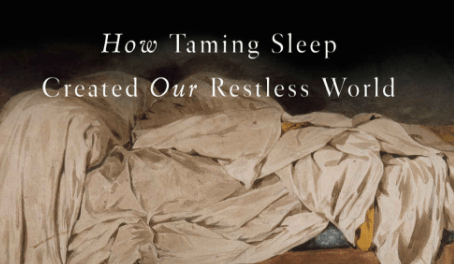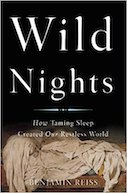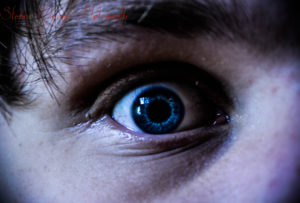Wild Nights: How Taming Sleep Created Our Restless World
As with many things in our history, humans have spent much effort trying misguidedly to control the natural instinct to sleep. Basic Books
Basic Books
“Wild Nights: How Taming Sleep Created Our Restless World” A book by Benjamin Reiss

Purchase in the Truthdig Bazaar
Are you happy with the amount of sleep you get each day?
Are you alert and energized at work, especially after lunch?
Do your kids fall asleep as soon as the lights are off?
Is anyone out there reading this satisfied with the state of his or her sleep?
According to Benjamin Reiss, author of “Wild Nights: How Taming Sleep Created Our Restless World,” the answer to all these questions is most likely a groggy no. Like our history with animals, vegetables and minerals, as well as other humans and pretty much anything else within our reach in the natural world, we have spent much of our time and brain energy trying to control the otherwise natural instinct to sleep. Reiss notes that nowadays, this has devolved into a sleep industrial complex that involves:
… sleep mattress companies, peddlers of self-help, big coffee chains, drowsy truckers, public health professionals, hyper-stimulating electronic devices, napping consultants, high-speed travel and higher-speed communications, scientific researchers, military planners, risk assessment professionals, labor organizers, government regulators, space travel researchers, self-monitoring systems, smartphone sleep apps, sleep coaches, online sleep therapy programs, and even smart beds that analyze our patterns, of movement, breath and perspiration.
And let’s not forget even newer inventions like a soundwave headband, light-emitting goggles and a pulsating ring. We’ve become absolutely sleep obsessed, and in “Wild Nights” Reiss asks the very simple question one asks years into a complicated relationship in need of intervention: How did we get here? The answer is an illuminating, sometimes repetitive, but ultimately revealing history of sleep. Reiss is “a literary scholar by training, and a cultural historian by inclination” and relies more on literary work than scientific studies in “Wild Nights,” which creates a rather colorful tapestry of the many ways humans have tried to conquer sleep.
Reiss’ driving argument is that our most widespread notions of normal sleep—the straight eight-hour nightly sojourn in a private, quiet space, with no more than two adults sharing a bed—is a modern Western idea that, along with capitalism and the wide-scale destruction of our environment, was spurned by that catalyst of catalysts, the Industrial Revolution. Reiss stresses that “none of these rules is anything close to universally sanctioned across cultures or historical periods and several of them would seem quite odd to people in times and places other than the twentieth- or twenty-first century West.” Before the industrial era, the standard was actually something more like segmented sleep: “these two sleeps—sometimes called first and second sleep, sometimes ‘dead sleep’ and ‘morning sleep’—bridged an interval of ‘quiet wakefulness’ that lasted an hour or more.” And privacy? Until the industrial age, “only the aristocracy possessed sufficient wealth for such luxury … (and) even the idea of a ‘bedroom,’ denoting a room primarily associated with sleep, is rather new.”
With the advent of the light bulb and factories, this all changed. Those with means suddenly had more hours of light to stay awake and amuse themselves, and more money for bigger homes. Suddenly, children needed to sleep in their own rooms so the grown-ups could play. Railroads began to appear with regularity and, in addition to waking those they rumbled past, brought raw materials into factories and finished products out at all hours of the day. The same factories needed to have workers that were as mechanically consistent as the machines they controlled, which birthed the rather depressing motto: “Eight hours of work, eight hours of sleep, eight hours for what you will.” Unfortunately, those eight hours of work might be at night, when you were supposed to be sleeping. For the first time, humankind had the ability to carve time to its liking on a scale never before seen, as well as a compelling commercial reason to do it. The West’s obsession with sleep had begun.
To highlight this pivotal moment in sleep history, Reiss devotes an entire chapter early in the book to Henry David Thoreau’s environmental masterpiece “Walden.” While the book is revered more for its views on our relationship with the natural world, Reiss mines it for Thoreau’s many observations on sleep and how it “provides an unusually vivid picture of an emerging modern world in which the human sleep-wake cycle has been fundamentally damaged: people have forgotten both how to sleep and how to be fully awake.” Reiss gravitates toward this physical and philosophical view of sleeping and waking, and returns to it and Thoreau throughout the book.
In “Walden,” Thoreau astutely observes the changes regarding time and information, and how those changes affect sleep. With the advent of the railroad, he notes that trains “go and come with such regularity and precision, and their whistle can be heard so far, that the farmers set their clocks by them, and thus one well-conducted institution regulates a whole country.” With newspapers and telegrams speeding up information in a way only rivaled by the change brought by the internet, Thoreau notes that “Hardly a man takes a half-hour’s nap after dinner, but when he wakes he holds up his head and asks, ‘What’s the news?’ as if the rest of mankind had stood his sentinels.” Nineteenth century FOMO (fear of missing out).
While at Walden Pond, Thoreau realizes that a body is intricately tied to the environment it inhabits, and that sleep is a window into that relationship. He observes that getting the right amount of sleep is crucial, and that:
Little is to be expected of that day … to which we are not awakened by our Genius, but by the mechanical nudging of some servitor … are not awakened by our own newly acquired force and aspirations from within, accompanied by the undulations of celestial music, instead of factory bells, and a fragrance filling the air. We must learn to reawaken and keep ourselves awake, not by mechanical aids, but by an infinite expectation of the dawn.
But Thoreau is touching on something beyond sleep; he is speaking about modernization as a whole, and how technology can be a wedge between our humanity and its direct link to nature. Thoreau understood that if we were not careful, the machines and tools could irreversibly disrupt our natural tendencies. He ominously notes that “We do not ride on the railroad; it rides upon us.” If Thoreau were alive today, he would follow that quotable tweet with an emphatic #staywoke.
For Reiss, Thoreau is prescient and “Walden speaks powerfully to the origins of many of our contemporary sleep troubles, and it presents a more capacious way of thinking about the human sleep-wake cycle than the supposedly expert advice with which we are so frequently bombarded today.”
It is clear why Reiss devotes a large chunk of his book to this one literary work, but the chapter is so deep and engrossing that the remaining chapters do not entirely advance his original argument. The rest of the book explores the many ways we have been trying to conquer sleep ever since Thoreau, but the laser focus of the “Walden” chapter gives way to a dazzling, but perhaps too varied, kaleidoscope of methods by which we have sought to engineer sleep.
Sleep naturally touches on every facet of life, but without focusing on a specific aspect (why sleep training those stubborn toddlers is bad for them or how we as a culture can overcome that afternoon slump), the book begins to feel too expansive. It jumps from Cotton Mather to a kibbutz in the ’80s, from hysterical Victorian mothers to co-sleeping parents, from slave ships to sleep labs in the 2000s. Not all in one chapter of course, but still. At a certain point, Reiss is not ashamed to admit that the readers are going to “fast-forward from the distant past, through the industrial age, to the present and into the future of sleep—and back again.” It’s enough to give one whiplash.
Near the end, he mentions Kanye West’s controversial video “Famous,” depicting multiple celebrities sleeping in one bed. As if to highlight the all-encompassing nature of his chosen subject, Reiss makes strange bedfellows out of two oddballs on either end of the time spectrum: “In abandoning the old rules in search of a better, less restrictive kind of sleep, we might seek to recapture the tranquility of Thoreau’s cabin. But instead, we might find ourselves in bed with Kanye.” I get it, sleep touches everyone’s lives because everyone sleeps, but this reader failed to see what else Henry and Yeezy have in common.
Reiss does make some rather interesting connections that even Thoreau could not have predicted: He notes with irony that the iPhone that contributes to so many of us sleeping less—which now includes functionality to emit less “blue light” that is keeping us awake, and which also houses apps that help us monitor our sleep with the aim of sleeping more—is also a device that is produced halfway across the globe, where Chinese workers are demanded to “stay at the job for 11.5 consecutive hours. … Day-shift and night-shift workers in the plant were made to sleep eight to a dorm room, stacked on hard, narrow cots, where they suffered the inevitable interruptions of sleep as their roommates came and went on different schedules.” We do not use the iPhone; the iPhone uses us.
Despite the many tangents he traverses in “Wild Nights,” the one cohesive thread Reiss weaves is one that we experience on a daily (or rather, nightly) basis: Our world doesn’t let us sleep in peace. It isn’t just the early morning garbage truck or the addiction to Starbucks. It seems that in our modern world, sleep is no longer a natural activity, but a problem in need of fixing. Our culture conspires with our devices, labors, appointments and pursuits to keep us from getting the quality and quantity of sleep we naturally desire. We now have new ways of monitoring, managing, inducing and reducing sleep, but Reiss would argue that our solutions are actually at the heart of the problem. Sleep should not be controlled and yet through Reiss’ analysis, it seems that for us modern Westerners, the damage is already done. We’ve made our proverbial bed, and yes, we’ll have to sleep in it, in however way we can.
Reiss ends with perhaps his dream all along, an image of him sitting in one of the three chairs Thoreau had in his cabin in the woods, hoping for the chance to be awakened not by an iPhone alarm, but by an infinite expectation of dawn.
Your support matters…Independent journalism is under threat and overshadowed by heavily funded mainstream media.
You can help level the playing field. Become a member.
Your tax-deductible contribution keeps us digging beneath the headlines to give you thought-provoking, investigative reporting and analysis that unearths what's really happening- without compromise.
Give today to support our courageous, independent journalists.






You need to be a supporter to comment.
There are currently no responses to this article.
Be the first to respond.